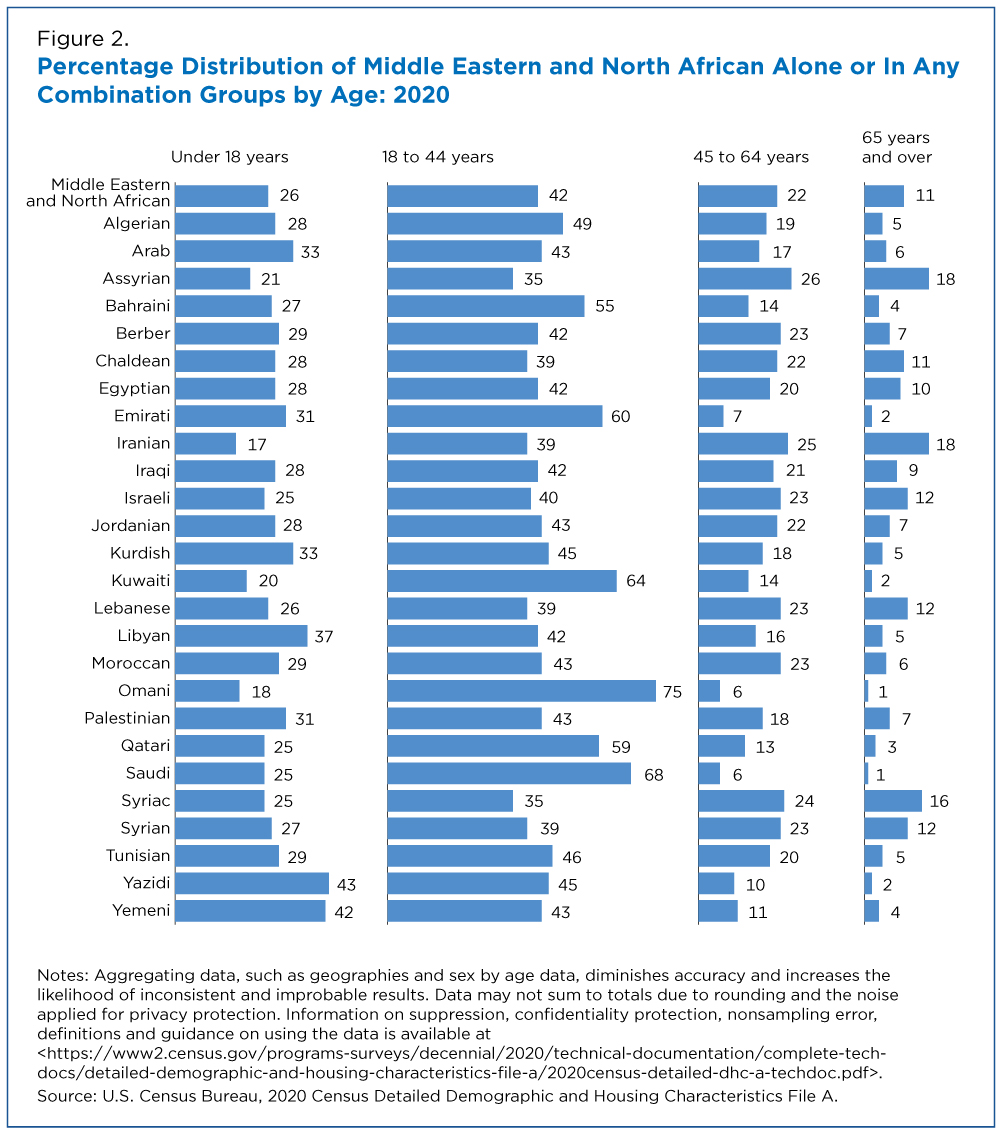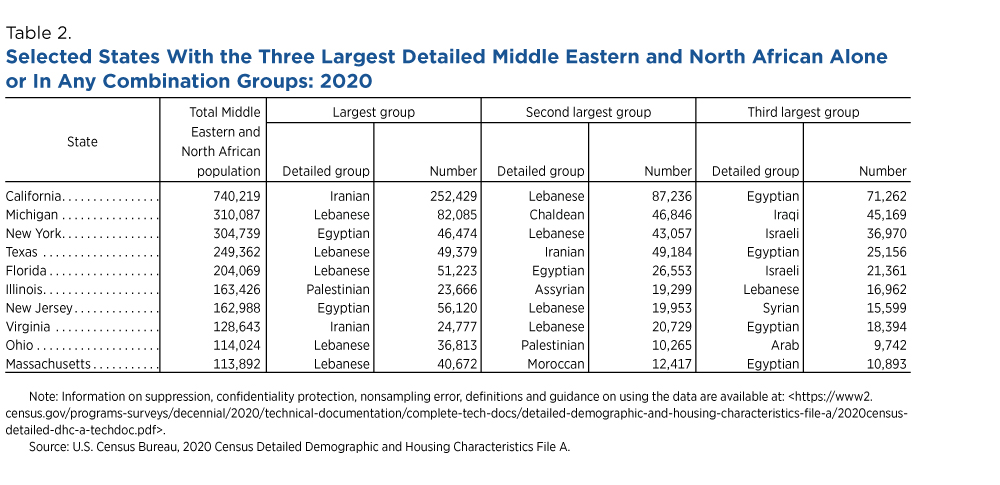Lebanese, Iranian and Egyptian Populations Represented Nearly Half of the MENA Population in 2020 Census
Lebanese, Iranian and Egyptian populations represented nearly half of the 3.5 million who reported Middle Eastern and North African (MENA) descent in the 2020 Census — the first census to specifically solicit MENA responses.
The Census Bureau’s classification for the MENA population is geographically based and includes Arabic-speaking groups, such as Egyptian and Jordanian, and non-Arabic speaking groups, such as Iranian and Israeli. It also includes ethnic and transnational groups from the region, such as Assyrian and Kurdish.
In response to public feedback and testing over the last decade, the U.S. Census Bureau added a write-in response area to the White racial category, including German, Irish, English, Italian, Lebanese and Egyptian as examples.
The MENA examples were included with the White category following the standards [PDF <1.0 MB] set by the U.S. Office of Management and Budget in 1997, which classify MENA responses as part of the White racial category.
In this article, we use the Census Bureau's classification for the MENA population, which is based on our ongoing research and outreach efforts with community experts, stakeholders, and researchers and the results of the 2015 National Content Test [PDF 15.6 MB].
The Census Bureau’s classification for the MENA population is geographically based and includes Arabic-speaking groups, such as Egyptian and Jordanian, and non-Arabic speaking groups, such as Iranian and Israeli. It also includes ethnic and transnational groups from the region, such as Assyrian and Kurdish.
Here we present data on detailed responses to the race question in two forms: “alone” and “alone or in any combination.”
The “alone” count represents the minimum number of people who identified as a detailed group. It includes those who reported only one response, such as Egyptian.
The “alone or in any combination” count represents the maximum number of people who identified as a detailed group. It includes those who reported only one response, such as Egyptian, and those who reported multiple responses, such as Egyptian and Moroccan or Egyptian and Black or African American.
These definitions are important to frame the discussion of racial and ethnic composition and help us understand our country’s changing demographics as it becomes much more multiracial.
Who Identified as a Detailed MENA Group?
In 2020, over 3.5 million people identified as MENA alone or in any combination with another group, accounting for 1.5% of the White alone or in combination population. Within this population, over 2.5 million people (1.2% of the White alone population) identified as MENA alone.
Together, Lebanese, Iranian and Egyptian, the three largest MENA groups, represented 46.9% (1,651,090 people) of the MENA alone or in any combination population (Table 1):
- The Lebanese population was the largest MENA alone or in any combination group with 685,672 people, accounting for nearly 20% of the MENA alone or in any combination population. The Lebanese population was also the second largest MENA alone group, with 328,137 people or 12.9% of the MENA alone population.
- Iranian was the largest MENA alone group with 413,842 people and it was the second largest MENA alone or in any combination group (568,564 people), representing over 16% of the MENA alone and alone or in any combination populations in 2020.
- Egyptian was the third largest MENA group. Over 12% of the MENA alone population identified as Egyptian alone and 11.3% of the MENA alone or in any combination population identified as Egyptian alone or in any combination.
- The next largest MENA alone or in any combination groups were responses classified as “Other Middle Eastern and North African” (which refers to people who reported general terms such as “Middle East,” “North African,” as well as responses such as “Druze” and “Bedouin”), Arab (which refers to those who reported a response of “Arab” or “Arabic”), Syrian, Iraqi, Israeli, Palestinian, Moroccan and Jordanian, which all had populations of over 100,000.
MENA Population by Sex and Age
Nationally, all MENA alone or in any combination groups met the minimum population counts required for producing sex-by-age data. About 26% of the total MENA population was under age 18; 42% ages 18 to 44; 22% ages 45 to 64; and 11% age 65 and over (Figure 2).
The Yazidi and Yemeni populations had the largest shares of people under 18 years of age (43% and 42%, respectively). In contrast, the Iranian and Omani populations had the smallest shares of people under 18 years (17% and 18%, respectively).
Over two-thirds of the Omani (75%) and Saudi (68%) populations were between the ages of 18 to 44. The Assyrian and Syriac populations had the smallest population shares (35% each) of 18- to 44-year-olds.
Under 10% of Omani (6%), Saudi (6%) and Emirati (7%) populations were between ages 45 and 64, and over a quarter of the Assyrian population (26%) was in that age group.
The share of those 65 years and older was less than 5% for eight groups: Bahraini, Yemeni, Qatari, Emirati, Yazidi, Kuwaiti, Saudi and Omani.
Over 15% of the Iranian (18%), Assyrian (18%) and Syriac (16%) populations were 65 years and over.
States With Largest MENA Populations
California, Michigan and New York had the largest MENA populations, with over 300,000 people reporting MENA alone or in any combination (Table 2). California had twice as many people identifying as MENA alone or in any combination (740,219 people) as any other state.
Lebanese was the only group that appeared in the top three largest detailed alone or in any combination groups in all ten states with the largest MENA populations while Egyptian appeared in seven of them. Palestinian appeared in the top three groups in Illinois and Ohio. Chaldean and Iraqi in Michigan, Assyrian in Illinois, Syrian in New Jersey, Arab in Ohio and Moroccan in Massachusetts all appeared once in the top three in those states.
Figure 3 shows the distribution of the nation's five largest detailed MENA alone responses in the ten states with the largest MENA alone populations. In the ten states, the "Other Middle Eastern and North African group" category was the largest share of the population.
Of the nation's five largest groups, the Egyptian alone population made up 39% of the MENA alone population in New Jersey.
In California, the largest of the five groups was Iranian alone (34%). Similarly in Texas and Virginia, the Iranian alone population was about a fifth of the MENA alone population and the largest of the five groups in those states (20% and 19%, respectively).
The Lebanese alone population was over a fifth of the MENA alone population in Massachusetts (24%), Michigan (22%), and Ohio (21%).
The Iraqi alone population was 15% of the MENA alone population in Michigan and 11% in Texas.
Detailed MENA Populations by County
In about a third of all counties (1,009), Lebanese was the largest MENA alone or in any combination group (Figure 4).
While prevalent in numerous counties across the United States, the largest concentration of the Lebanese population was in Wayne County, Michigan, where 33.9% of the 139,751 MENA respondents identified as Lebanese alone or in any combination. In Wayne County, home to the cities of Detroit and Dearborn, 7.8% of residents identified as MENA alone or in any combination, the highest percentage of any U.S. county.
The Iranian alone or in any combination population was the largest MENA group in 95 counties. The counties with Iranian as their largest MENA group were concentrated in California and in and around Washington, D.C. The county with the largest population of Iranians was Los Angeles, California (101,632), where 44.4% of MENA respondents reported they were Iranian alone or in any combination with another group.
From Suffolk County, New York in eastern Long Island to Atlantic County in southern New Jersey, Egyptian was often the largest MENA alone or in any combination group. In total, it was the largest group in 74 counties.
Several other groups were concentrated in different parts of the country. The Iraqi population, for example, was the largest MENA group in 24 counties, including San Diego County, California, and several throughout the Midwest. The Palestinian population was the largest MENA group in 27 counties, including several in the Chicago area.
Data Visualization
Related Information
The Technical Documentation [PDF 10.6 MB] provides more information on data quality and how the Census Bureau collects, codes and tabulates statistics on race and Hispanic or Latino origin.
Information on the application of differential privacy and data accuracy for the 2020 Census at various levels of geography are available on the 2020 Census Data Products Disclosure Avoidance Modernization webpage.
2020 Census Detailed Demographic and Housing Characteristics File A on America Counts
9/21
9/26
10/3
10/10
10/17
10/24
Related Statistics
Stats for Stories
Subscribe
Our email newsletter is sent out on the day we publish a story. Get an alert directly in your inbox to read, share and blog about our newest stories.
Contact our Public Information Office for media inquiries or interviews.












